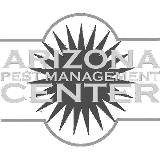Marestail and Fleabane have become increasingly widespread in recent years. This has occurred mostly in areas around field edges, roads, ditchbanks citrus groves and alfalfa fields. Marestail (Conyza candensis, also called horseweed), has been here for many years while Flaxleaf Fleabane (Conyza bonariensisis) is more recent. Both are in the Conyza genus and the sunflower family. Both are described as summer annuals, but they grow year round in the low desert. Although these two weeds are easy to distinguish once they are established and have several leaves, the seedlings look very similar. They form a rosette like shepardspurse, soon after emerging. After they bolt Marestail puts up a tall central stem that is dark green with long thin leaves. Fleabane, on the other hand, does not have a central stem but has several branches with smaller, grey thin leaves. Marestail can get 10 foot tall while fleabane rarely gets taller than 3 to 4 feet.(See picture below)
Controlling both of these weeds can be difficult because they grow rapidly, and plant populations have developed resistance to Glyphosate in many areas. Glyphosate still works well on Marestail in many areas here but there have been increasing misses. This is a characteristic of resistance, but it has not been tested or confirmed here. It has been confirmed throughout California. We did not have these weeds in many of our older herbicide trials and are now working to update our information on herbicides in alfalfa and citrus, specifically for these weeds and with some of the newer herbicides. In a few of our older trials where we had some marestail we did have good control with 2,4-DB but only partial control with trifluralin. These weeds can germinate any time of the year and trash on the surface will reduce control in citrus. We did not have fleabane in these early trials. We have had good control with Sharpen (Treevix, Kixor) postemergence and Chateau preemergence on many broadleaf weeds but do not have enough data on fleabane or marestail yet. It is on the labels for both herbicides and we will have current data later this season.






